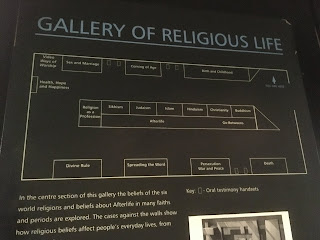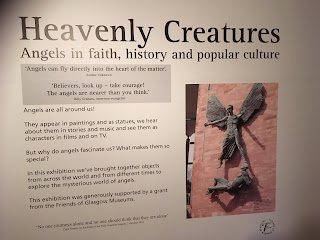We travelled by train to St Mungo Museum in Glasgow on Tuesday morning. It is a religious life and art museum named after St Mungo the patron saint of Glasgow. The Learning and Access Curator spoke to us on the challenges of exhibiting sacred items and how the museum tried to avoid segregation of different religions, instead taking on a thematic approach and mixing items from different religions together.
We got given an exercise to discuss any difficult or controversial issues that may arise when preparing a display about religion. Some of the issues include:
- interpreting the objects in the wrong way and thus causing offence
- issue of ethics (for example, displaying of relics/human remains)
- putting a modern interpretation on an object and taking it out of its historical context
- trying to avoid preference over one religion to another
The Museum’s aim is to promote mutual understanding and respect between people of different faiths and of none.
The Museum is set up with a few different galleries - the Gallery of Religious Art, the Gallery of Religious Life (religion in everyday life) and the Scottish Gallery. There is also a temporary exhibition space. In the Gallery of Religious Life, there is a room with 6 displays showing the 6 main religions (6 faiths that have significant communities in Glasgow). These are Sikhism, Judaism, Islam, Hinduism, Christianity and Buddhism.
In terms of interpretation of displays, they use comparative/inter disciplinary and thematic displays, key interpretative text and personal testimony.
Some of the challenges they face are displaying controversial subjects and objects, Aniconic religions, and having a Western interpretation of religion.
We got given a practical exercise to choose objects from a table and create an imaginary exhibition from them on a particular topic (eg. worship, prayer, pilgrimage, feasting, fasting, gender). My group chose the topic of items being taken out of their religious context and being popularised in modern culture (eg. the cross being used by secular people as jewellery and house decoration - this also applies with Buddhist statues in the home).
We got time to explore the Museum and go up to the temporary exhibition on Angels called ‘Heavenly Creatures’ which was interesting. We also walked up to the Necropolis and got a view over Glasgow, and also Glasgow Cathedral.
In the afternoon, a group of us went to the Willow Tea Rooms (Charles Rennie Mackintosh tea rooms) for afternoon tea which was nice.










No comments:
Post a Comment